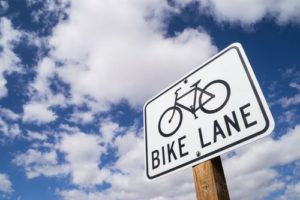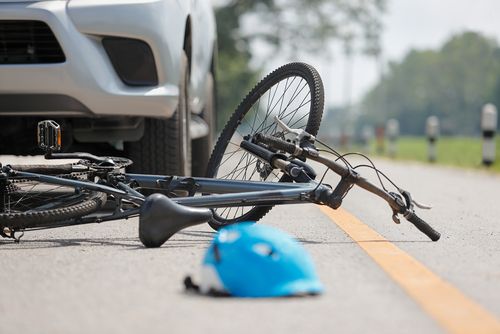 Being a Responsible Bicycle Rider
Being a Responsible Bicycle Rider
Riding a bicycle is great exercise, a fuel-efficient means of transportation, and a lot of fun. The more you know about California bicycle laws, the safer your time on the state’s busy streets will be.
Riding through traffic without the metal body of a car to protect you makes you much more vulnerable to serious injuries. Each year, more than 100 bike riders die in California due to collisions. Another 10,000+ suffer from crash-related injuries. It isn’t just the responsibility of the drivers on the road to make bike riding safe. As a bike rider, it’s your responsibility to know where and how to ride.
Basic California Bicycle Laws
Generally, bicycle riders have the same rights and responsibilities as those driving motor vehicles. Still, many accidents occur when other motorists fail to acknowledge those rights. Even when you ride according to the state laws, always stay alert and make your intentions known.
When to Take the Lane
Bike riders are typically required to stay as close to the right side of the road as possible. The exceptions to the rule include when you’re passing, getting ready to make a left turn, trying to avoid a road hazard, when the lane is too narrow to share, or if the right lane is a turning lane.
Using the Bicycle Lane
A bicycle lane makes it easier for bikers and motorists most of the time. While the designated bike lane keeps bikes separate from the traffic, the same exceptions for ‘taking the lane’ apply. Stay in the bike lane unless turning left, passing, avoiding a road hazard, or where there is a right turning lane.
Ride in the Direction of Traffic
There was a time when people debated which side of the road was the safest for bikers. Today, California bicycle laws clearly state that bike riders must ride on the right side of the roadway in the same direction as traffic. The law doesn’t apply while riding on one-way streets, roads that are too narrow, while passing or making a legal left turn, or when the right side of the road is closed during construction.
Crossing Toll Bridges
Bicycle riders aren’t permitted to cross toll bridges other than those permitted by the state’s Department of Transportation.
Riding on the Sidewalk
California bicycle laws neither allow nor prohibit bike riders from riding on sidewalks. Instead, the law permits cities and counties to determine whether sidewalks are off-limits. Although the sidewalk might seem like a safer place to ride when there isn’t a bike lane, a number of risks make it just as dangerous, if not more so.
In rural areas, cars frequently enter and exit their driveway, putting you at risk of being struck. The greatest risk is from drivers backing out of driveways who aren’t likely to see you. Highly populated areas are less likely to allow you on sidewalks due to the risk of hitting pedestrians.
If there’s no sign stating that bicycles are prohibited from riding on sidewalks, then it’s legal to do so.
Wearing a Helmet
All bicycle riders under the age of 18 years must wear a bicycle helmet on a public street or road, bikeway, or public path or trail. This not only includes the driver, but children riding in restraining seats or those towed behind the bike as well.
Helmets must fit well, be fastened, and meet California’s certification standards. The fine for failing to wear a helmet is small, but the price for failing to wear a helmet can be extremely high if you have an accident.
Electrical Bikes
A number of variations of electrical bikes exist. Some are no more than standard bicycles with a motor attached, capable of going low speeds without pedaling. Those classified as Types 1 and 2 are capable of speeds of no more than 20mph. The same rules that apply to regular bikes apply to low-speed electrical bikes. The California DOT posts signs in areas where electric bikes of any kind aren’t allowed. Neither manual nor electrical bikes are permitted on freeways or expressways.
Mopeds and other electric bikes that reach a top speed of 28mph can’t be ridden on bike paths or trails. Exceptions apply to those areas where local authorities permit bikes and those with bike lanes or separate bikeways.

Common Sense Safety Tips for Bicycle Riders
Most of us learn to ride a bike as kids. Once you know how, it’s something you never forget. How easy it can be to ride a bike, even for a child of five or six years, makes taking precautions like driving in certain places and maintaining control seem silly. After all, how dangerous can a piece of metal with two wheels be?
The reality is that the number of accidents involving motor vehicles and bicycles is on the rise. In nearly every situation, it is the person on the bicycle who is injured, often seriously. In 2014, bicyclists made up 2% of the total number of traffic deaths in this country. The average victim was male, between the ages of 20 and 24 years, and lived in an urban area, and more than 20% were intoxicated. With about twice as many bicycles in California as in other states, the statistics are stacked even further against you.
A growing number of people in CA have turned to bicycling. It saves a lot of money on fuel costs and is an environmentally-friendly alternative to driving a car. The state also offers great views and new experiences with its varied terrain. No other method of transportation offers a greater combination of exercise and entertainment.
As more bikers enjoy the various advantages of riding a bike offers, the number of crashes grows too. Accident prevention begins with learning and obeying California bicycle laws. Don’t disregard the impact something like wearing a helmet has on your safety.
It’s also important to stay alert at all times. Make yourself visible and make every effort to let drivers know your intentions. Also, make the right choice in bikes to make it easier to keep your bike under control. Not only do the right features make a difference in how safe your bike is to ride; certain features are requirements under California bicycle laws.
- Brakes – Fixed gear bicycles are popping up all over. Although they tend to cost more than regular bikes, they lack some of the features that one might expect on a standard bicycle. Most significantly, gears and brakes. If you decide to join the trend in California, you’ll be breaking the law! The state requires every bicycle to have a one-braked-wheel that allows the driver to skid on dry, clean, level pavement.
- Size – When it comes to being able to control your bike, size matters. California law requires bicycles to be small enough for the rider to stop and support it with one foot firmly on the ground.
- Handlebar Height – The law mandates that handlebars not be higher than your shoulders. To ensure comfort, look for handlebars that are about shoulder width apart.
- Reflectors – Reflectors do more than make your bike look cool. They also reflect light that lets drivers know where you are. CA law requires a number of reflectors, including those on the back, front, and sides. For bikes with reflectorized front and rear tires, reflectors aren’t required.
- Headlights – You don’t need the equivalent of daytime running lights but you do need a white headlight that is visible from the front. It should be either attached to your bicycle or to you.
- Seat – The only bicycles not required to have a permanent seat are those manufactured to be ridden in this way. Also, passengers that weigh under forty pounds require a seat to hold them in place and to provide a barrier between them and moving parts.
Bicycling Accidents in California
Like vehicle drivers, bicyclists aren’t permitted to drive under the influence. They can’t wear earplugs or use a headset covering both ears or carry items that prevent them from keeping one hand on the handlebars at all times. Although the law doesn’t prevent bicyclists from using a cell phone while riding, it’s never a good idea to take your attention away from your riding and the nearby traffic.

When an Accident Happens
When a crash occurs between a vehicle and a bicycle, the bicycle rider is prone to more severe injuries. Medical bills are more likely to be higher while the loss of property damage is low. There is nothing to protect you from the impact of the vehicle, putting you at risk of severe, lifelong injuries and disability.
Your options for collecting compensation for your injuries depend on who is at-fault for the accident. California is a shared negligence state. This means, you could be partly at fault for the accident. That doesn’t mean you can’t get compensation; only that you might not be able to collect 100% of your damages.
For example, if you disobey any of the California bicycle laws when the vehicle strikes you, then you are partly to blame. If you are driving at night without a light on your bicycle when the vehicle runs into the bicycle lane and hits you, the accident might be 20% your fault. You can only collect 80% of the total damages.
If you are riding at night, without a light, on the left side of the road when the car goes off the shoulder and hits you, then you share an even greater portion of the guilt. That doesn’t mean that you can’t collect compensation. This is especially true if you have severe injuries and the amount of damages is very high and/or you require long-term treatment.
Failing to obey the bicycle laws in California not only puts you at a greater risk of having an accident. It can also have a significant impact on your ability to obtain financial compensation.
People who receive severe injuries experience an impact on every facet of their lives. While trying to heal, they are faced with having to battle insurance companies and trying to prevent complete financial devastation. Many never heal to the degree that they can earn a living or lead a normal life again.
The Best Time to Contact a Personal Injury Attorney…and Why!
Dealing with an injury and trying to get the medical treatment needed to heal is often overwhelming. If you suffer from chronic pain, the last thing you want to think about is filing a personal injury claim.
Many people fail to realize that there is a limited time for filing a personal injury claim. The ‘statute of limitations’ allows victims of personal injuries a specified amount of time to start the process. Once that time passes, you lose your right to seek compensation.
Initially, your injuries might not seem that serious. You may think that short-term treatment is all you require. Some injuries don’t surface until later. Serious injuries may not heal as expected or secondary conditions might develop. One example is developing an infection from a bone fracture.
Schedule an evaluation with an experienced personal injury attorney immediately after your accident. This is the only way to find out for certain if you have a good case. It also ensures your claim is filed within the statute of limitations and according to the law. If you don’t have a good case, you don’t lose anything. The initial consultation is free.
Most people don’t know the laws related to personal injury or their rights. In most cases, it is the at-fault driver’s insurance company that you will negotiate with. A personal injury attorney knows the tactics insurance companies use to keep from giving you a fair settlement. They also know how to value your case so that you get the compensation you need to heal. The sooner you make an appointment, the more effective you and your lawyer will be at documenting your injuries, treatments, and your financial damages.
Contact Batta Fulkerson for a 100% free evaluation of your case. We’ve helped many other clients get a fair settlement and we can help you. Get a personal injury attorney who is ready to fight for you and pay nothing until we win.




